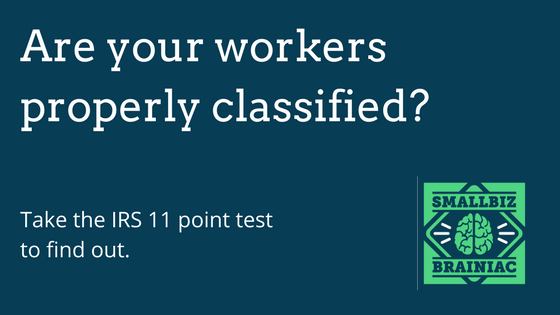Independent Contractor or Employee?

Independent Contractor or Employee?
Do you remember from episode 3 of the SmallBiz Brainiac podcast, the examples of employers who have been and are currently being sued for improper classification of their workers? Click here to listen to that episode. In this post we’ll learn about the IRS Common Law Rules and the 11 point test for determining if a worker is an independent contractor or an employee.
This isn’t an issue you want to mess around with.
If you use independent contractors, you need to take some time to slap the facts of your situation up against the 11 point test outlined in the common law rules.
The quick explanation is this:
If you have the right to control or direct only the results of the work and not how it will be done, or what will be done, then you have an independent contractor relationship.
If you’re thinking, that’s pretty subjective, it is. In an IRS video on worker classification they say that there is no “magic” or set number of factors that make the worker an employee or an independent contractor, and no one factor stands alone in making this determination.
Also, factors that are relevant in one situation may not be relevant in another. AWESOME, right!
The IRS 20 point test for examining the worker relationship was replaced by an 11 point test that focuses on these three categories, behavioral control, financial control and the relationship between you and the worker.
These are known as the common law rules and it’s how the IRS is going to make their determination.
You’ll need to scrutinize the worker relationship by considering all the evidence
Behavioral Control:
First up – behavioral control which focuses on the degree of your rights to direct and control what work is accomplished and how the work is done.
What instructions do you give the worker?
You tell your employees how, when and where to do the work so if you’re telling the independent contractor the same things, then the chances are they’re an employee too.
Ask yourself these questions
Do I tell the worker…
- when and where to do the work?
- what tools or equipment to use?
- what workers to hire to assist them with the work?
- where to purchase the supplies and services they’ll use to complete the work?
- what work must be performed by a specified individual?
- what order or sequence to follow to get the job done?
Even if your answers are no, you may still have the right to control so ask yourself these questions again saying “Do I have the right to tell…”
A workers is an employee when you have the right to direct and control the way they do the work, even if you don’t actually exercise that right.
What training to give them?
If you are training an independent contractor that isn’t good. They need to be using their own methods.
Financial Control:
Next up is financial control.
This is about whether or not there is a right to direct and control the business part of the work.
Here are the test questions:
To what extent does the worker have unreimbursed business expenses?
Independent contracts will typically have expenses that you don’t reimburse them for. Having fixed costs regardless of whether they are doing any work for you or someone else is a good indicator.
Does the worker have a significant investment in their work?
Do they have an office or shop? Do they own tools, equipment or software used to perform the work? There is not an exact dollar test for this and, the worker doesn’t necessarily have to have a significant investment to be a contractor.
Does the worker have other customers?
Do they advertise their services? Are they available to take on other work?
How do you pay the worker?
An employee gets a regular wage whereas an independent contractor is paid a flat fee or on a time and materials basis?
Can the worker realize a profit or a loss?
Relationship of the Parties:
And finally, the type of relationship.
Do you have a written contract describing the relationship?
If you have a verbal agreement or only the payment terms are written, get a full-fledged agreement executed.
Do you provide the worker with employee-type benefits like insurance, a pension plan, or vacation or sick pay? If you do, that’s probably a deal killer.
How long will the relationship last?
Will it continue indefinitely or for a specific project period? Indefinitely says they are more likely an employee.
Are the worker’s services a key aspect of the regular business of your company? If so, you’re probably either directing or controlling their activities.
That’s the test. Clear as mud, right? Well, don’t worry, the IRS is here to help! If you want the IRS to make the determination for you, simply fill out form SS-8 and send it in. I’m sure they will get back to you promptly!
If you think you might have an issue, contact an employment attorney and ask them to explain the Voluntary Classification Settlement Program, or Section 530 of the Revenue Act, which provides an opportunity for taxpayers to reclassify their workers as employees for employment tax purposes with partial relief from past due federal employment taxes, if certain requirements are met. If you are ever audited by the IRS for compliance, the Examiner must explore the applicability of section 530 even if you don’t bring it up.
However, there are certain factors in order to get Section 530 relief all of the following must apply: You can read more about this by going to the show notes for this episode and clicking on the Section 530 Relief link.
We need to demand the right to decide for ourselves what type of employment relationship we wish to enter into without all these regulations. We shouldn’t have to jump through hoops like circus animals. At the very least workers should have the freedom to chose between the two arrangements.
Government has stolen that ability from us and they’ve created a monstrous bureaucratic apparatus that oppresses productivity and increases the cost of labor through compliance expenses, all under the premise that we are too dumb and irresponsible to know what’s best for ourselves.
Freedom empowers the individual!
SUMMARY
A workers is an employee when you have the right to direct and control the way they do the work, even if you don’t actually exercise that right.
If you use independent contractors you need to look at the common law rules and take the 11 point test.
If there is any question about whether or not you are paying employees as independent contractors, call an employment law attorney to discuss your situation and look at the possibility of qualifying for Section 530 relief under the Classification Settlement Program.
Address the issue proactively rather than wait for an employee, the IRS, or some other government agency to come knocking.
Resources:
I know there are a lot of links here but I want you to see the variety of information the IRS has published on this subject.
IRS Webinar on Worker Classification. This is guaranteed to put even the most die hard insomniac to sleep!
http://www.irsvideos.gov/ProperWorkerClassification
IRS Brochure – Independent Contractor or Employee?
https://www.irs.gov/pub/irs-pdf/p1779.pdf
IRS Tax Topic 762 – Independent Contractor vs. Employee
https://www.irs.gov/taxtopics/tc762.html
IRS Small Business and Self-Employed Website – Independent Contractor Defined
https://www.irs.gov/Businesses/Small-Businesses-&-Self-Employed/Independent-Contractor-Defined
IRS Brochure – Subcontractors. This document is strange. It looks like it was created about 20 years ago but it has the current test information. Really strange.
https://www.irs.gov/pub/irs-regs/subcontractorstext.prn.pdf
Section 530 of the Revenue Act of 1978
https://www.irs.gov/irm/part4/irm_04-023-005r.html#d0e222
IRS Brochure – Do You Qualify for Relief Under Section 530?
https://www.irs.gov/pub/irs-pdf/p1976.pdf
Voluntary Classification Settlement Program
Internal Revenue Manual – Section 6: Classification Settlement Program (CSP)

